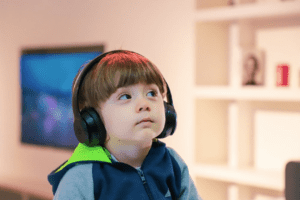How do you develop your child’s fine motor skills?
Are you concerned about your child’s fine motor skills? Do they have difficulty using a fork or
spoon to feed themselves, or trouble picking up small items? You aren’t alone.
But first, what are fine motor skills? Fine motor skills are finger and hand skills that are involved
in the manipulation of smaller objects using movements such as grasping and pinching. These
can include skills such as writing or drawing, doing and undoing buttons, using scissors, and
opening packets. Fine motor skills are important for schooling, dressing, and self-care tasks,
and develop from the shoulder to the fingertips.
Kidsense provides the following as a guide for age-appropriate skills. It is important to note that
all children develop differently and may develop some skills appropriate for their age range
quicker or slower than others.
| Age | Skills |
| 0-6months | ● Reflexive grasp (birth) ● Global ineffective reach for objects (3 months) ● Voluntary grasp (3 months) ● 2-handed palmar grasp (3 months) ● 1-handed palmar grasp (5 months) ● Controlled reach (6 months) |
| 6-12 months | ● Reaches, grasps, puts objects in the mouth ● Controlled release of objects ● Picks things up with a pincer grasp (thumb and one finger) ● Transfers objects from one hand to another ● Drops and picks up toys |
| 1-2 years | ● Builds tower of three small blocks ● Puts four rings on a stick ● Places five pegs on a pegboard ● Turns two or three pages of a book at a time ● Scribbles ● Turns knobs ● Paints with hold arm movement, shifts hands, makes strokes ● Self-feeds with minimal assistance ● Brings spoon to mouth ● Hold and drink from cup independently |
| 2-3 years | ● Strings four large beads ● Turns single pages of a book ● Snips with scissors ● Holds a crayon with thumb and fingers (not fisted) ● Uses one hand consistently in most activities ● Imitates circular, vertical, and horizontal strokes ● Paints with some wrist action, makes dots, lines, and circular strokes ● Rolls, pounds, squeezes and pulls playdough ● Eats without assistance |
| 4-5 years | ● Cuts on line continuously ● Copes cross ● Copies square ● Writes name ● Writes numbers 1-5 ● Copes letters ● Handedness is well established ● Dresses and undresses independently |
| 5-6 years | ● Cuts out simple shapes ● Copies triangle ● Colours within lines ● Uses a three-fingered grasp of pencil and uses fingers to generate movement ● Pastes and glues appropriately ● Can draw basic pictures |
| 6-7 years | ● Forms most letters and numbers correctly ● Writes consistently on the lines ● Demonstrates controlled pencil movement ● Good endurance for writing ● Can build Lego, K’nex, and other blocks independently ● Ties shoelaces independently |
| 7-8+ years | ● Maintains legibility of handwriting for the entirety of a story |
Implications of milestones not being achieved can include slow development of more difficult
and linked skills, difficulty playing with their peers at the same level, delayed development of
self-care skills such as feeding and dressing, and difficulty engaging in school activities at the
the same level as their peers.
So how do we support the appropriate development of fine motor skills? This changes depending
on the age of the child.
Development in Infants:
● Place your finger in the child’s hand and allow them to squeeze it.
● Engage in tummy time while the child is awake. As motor skills develop from the middle
of the body to the extremities, this gross motor activity will help the child to develop the appropriate trunk and chest control to engage in fine motor skills later in life.
● Place toys within reaching distance of the child.
● Encourage them to shift toys from one hand to the other.
● Encourage them to point.
● Let the child attempt to feed themself.
● Draw pictures together on butcher’s paper.
● Have the child place small objects into containers. Use safe objects for this.
Development in Toddlers:
● Make a picture book together by cutting simple pictures out of magazines or
newspapers.
● Encourage them to engage in art activities by providing large non-toxic crayons and
paper, or chalk.
● Play dress-ups and encourage the child to practice using large buttons and zippers.
● Complete basic puzzles together.
● Use playdough to make snakes, balls, or biscuits.
● Encourage finger painting.
● Build towers using blocks.
● Make necklaces using large beads or pasta.
Development in Older children:
● Encourage the child to complete drawing, writing, and colouring activities, or mazes and
dot-to-dots using pencils or non-toxic markers.
● Provide opportunities for the child to engage in their own self-care activities and practice
dressing and feeding themself.
● Play with water using cups and an eye dropper, clean syringe, or clean sauce bottle by
squirting it into another container.
● Threading strings, ribbon, or pipe cleaners through a colander.
● Use large tweezers to sort objects such as Pom-poms, counters, or large beads.
By practicing the skills listed above, children can be supported in the development of their fine
motor skills, which will stay with them throughout their lifespan.
If you still have questions, contact one of our Occupational Therapists on 0745 993 165.
Sources:
Days With Grey. 2022. 50+ Fine Motor Skills Activities. [online] Available at:
https://dayswithgrey.com/blog/50-fine-motor-skills-activities/ [Accessed 22 February 2022].
2016. Activities for Infants and Children. [ebook] Available at: [Accessed 22 February 2022]. Kid Sense Child Development. 2022. Fine Motor Development Chart – Kid Sense Child Development. [online] Available at: https://www.childrens.health.qld.gov.au/wp-content/uploads/PDF/publications/cychs-ages-stages.pdf [Accessed 22 February 2022].
Kid Sense Child Development. 2022. Fine Motor Development Chart – Kid Sense Child Development. [online] Available at: https://childdevelopment.com.au/
[Accessed 22 February 2022].
Understood.org. 2022. What Are Fine Motor Skills? | Understood – For learning and
thinking differences. [online] Available at: https://www.understood.org/articles/en/all-about-fine-motor-skills
[Accessed 22 February
2022].




